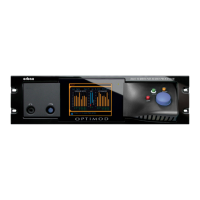3-22
OPERATION ORBAN MODEL 8685
To select a structure for the Surround processing, recall a factory preset or user hav-
ing the desired structure. If the 2.0 section of that preset has the wrong structure,
change it by importing a factory or user preset whose 2.0 section has desired struc-
ture (see page 3-25). For example, if the TV
5B-GEN PURPOSE factory preset is ac-
tive, importing the TV
2B-GEN PURPOSE preset will cause the 2.0 processing to
change from five-band mode to two-band mode. Once you have the combination of
structures you want, save the result as a User Preset, which you can leave unchanged
or edit as you wish.
You cannot change the structures of the Surround or 2.0 sections of a given preset
by editing them; the only way to choose a structure is to recall (Surround processing)
or import (2.0 processing) a preset having that structure.
Switching Between Structures: The AGC, equalizer, and look-ahead limiter are
common to both Two-Band and Five-Band processing and therefore stay the same
when the 8685 switches between two-band and five-band operation. However, dif-
ferent controls, as appropriate for Two-Band or Five-Band multiband compression,
appear in the screens containing dynamics processing controls. The meters also
change functionality to display the Two-Band or Five-Band gain reduction.
The Two-Band and Five-Band multiband compressor sidechains are independent and
always operate in the background. In the audio path, these structures both use the
five-band crossover. Two-Band processing uses bands 2 through 5 as the Master
band (above 200 Hz) by forcing their gains to be identical and controlling them with
the two-band sidechain. Meanwhile, the Two-Band sidechain creates the Two-Band
Bass band (below 200 Hz) by controlling band 1. Hence, switching between Two-
Band and Five-Band can be made seamless because the audio chain’s structure does
not change; the only thing that changes is the gain control sidechain.
To ensure seamless switching between a given two-band and five-band preset, it is
important to ensure that both presets are set up for approximately the same loud-
ness or to switch them during silence.
Pass-Through: P
ASS-THROUGH is a “soft bypass” function and is useful for any pro-
gram material that has been pre-processed for consistent loudness, like a network
feed. P
ASS-THROUGH defeats the AGC and multiband compressor gain reduction but
retains the look-ahead limiter (to prevent digital clipping), the equalizer, and the
loudness controller. P
ASS-THROUGH does not change the audio path like the 8685’s
B
YPASS function. Instead, PASS-THROUGH gain-ramps the AGC and compressor
sidechains to produce the desired bypass gain. This ramping occurs within one video
frame (approximately 30 ms). This gain ramping and the invariant audio path mini-
mize the likelihood that invoking P
ASS-THROUGH will causes clicks in the audio when
P
ASS-THROUGH is invoked during program material.
P
ASS-THROUGH’S most important parameter is the PASS GAIN control. In the factory
P
ASS-THROUGH preset, the equalizer is available but is set “flat” while the Loudness
Controller is available, but is set O
FF.
You can set the equalizer non-flat and save the result as a User Preset.
Duplicating the equalizer settings of the active preset to or from which
you switch may reduce the likelihood that switching to P
ASS-THROUGH

